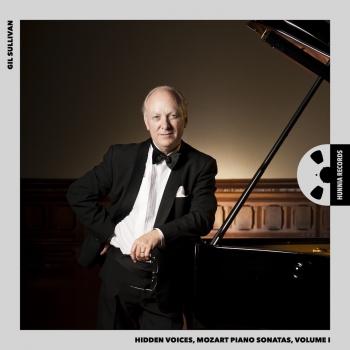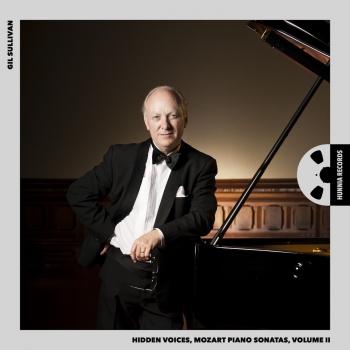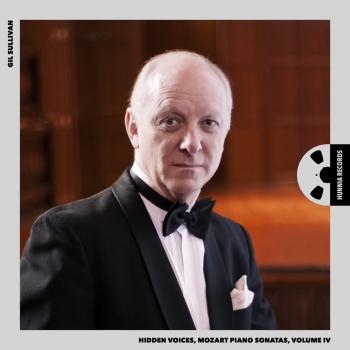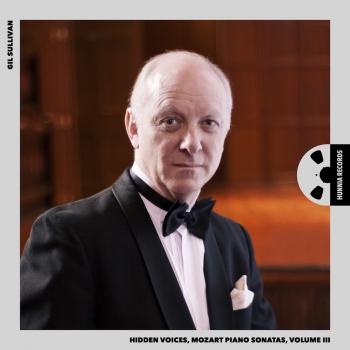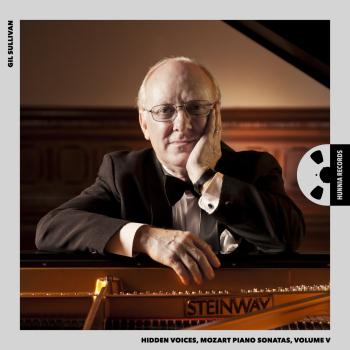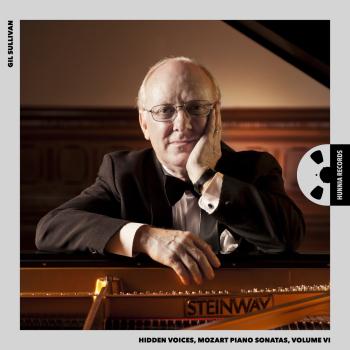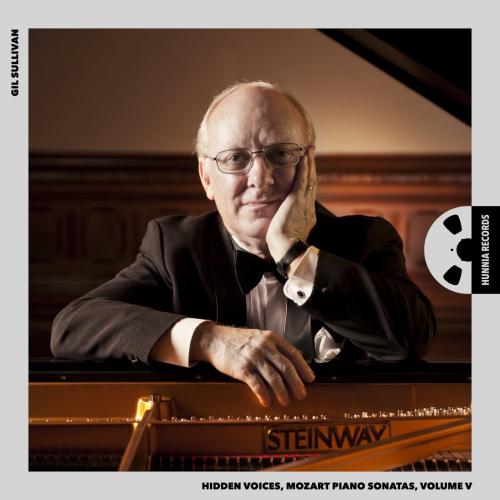
Hidden Voices, Mozart Piano Sonatas, Volume V Gil Sullivan
Album Info
Album Veröffentlichung:
2024
HRA-Veröffentlichung:
12.11.2024
Label: Hunnia Records
Genre: Classical
Subgenre: Instrumental
Interpret: Gil Sullivan
Komponist: Wolfgang Amadeus Mozart (1756–1791)
Das Album enthält Albumcover Booklet (PDF)
- Wolfgang Amadeus Mozart (1756 - 1791): Sonatensatz in G minor, K590d:
- 1 Sonatensatz in G minor, K590d: Allegro 05:53
- Sonata No.7 in C major, K309:
- 2 Sonata No.7 in C major, K309: I. Allegro con spirito 06:21
- 3 Sonata No.7 in C major, K309: II. Andante un poco adagio 05:49
- 4 Sonata No.7 in C major, K309: III. RONDEAU - Allegretto grazioso 07:28
- Sonatensatz in B flat major, K400:
- 5 Sonatensatz in B flat major, K400: Allegro 08:06
- Sonata No.10 in C major, K330:
- 6 Sonata No.10 in C major, K330: I. Allegro Moderato 07:26
- 7 Sonata No.10 in C major, K330: II. Andante cantabile 06:40
- 8 Sonata No.10 in C major, K330: III. Allegretto 06:44
- No.18 in D major, K576:
- 9 Sonata No.18 in D major, K576: I. Allegro 06:24
- 10 Sonata No.18 in D major, K576: II.Adagio 05:44
- 11 Sonata No.18 in D major, K576: III. Allegretto 04:47
Info zu Hidden Voices, Mozart Piano Sonatas, Volume V
Mozart was born at the close of the baroque era, so it seems only natural to consider his music in a more contrapuntal light. Yes, he did not grow up to be a late-baroque composer, though loved improvising fugues. He composed a Praeludium and Fugue in C (K394), plus the first three movements of a baroque suite also in C (K399). Late-baroque techniques and repertoire still circulated at the heart of that period’s musical vernacular, influencing all musicians in and beyond the second half of the 18th Cent. Written some 30 years before Mozart’s birth, we know as a youth he assiduously pored over Joseph Fux’s Gradus ad Parnassum. Still today the most significant and influential examination of Renaissance Polyphony ever written, it has never been out of print since 1725. (Haydn studied it in scrupulous detail, completing every single exercise). Mozart was not only highly conversant with polyphonic techniques, he initially used it to render musical unity and inner logic, whilst in his last 8-9 years in Vienna, it increasingly served as not only a compositional pillar, but as potent, intrinsic musical fibre.
We also know the bass line for Mozart was of extreme importance. He wrote - with great relish - many letters about orchestras across Europe boasting large numbers of double basses, plus 4 bassoons! No historically informed orchestra today would ever dream of having more double basses than cellos, and never! 4 bassoons.
In 1826 (35 years after Mozart’s death, and just a year before Beethoven’s), Hans Georg Nägeli, a Zürich philosopher and musicologist delivered a lecture in Stuttgart claiming Mozart’s love for excessive contrast was “the most styleless of the great composers”. “...both shepherd and warrior, sycophant and hothead...soft melodies frequently alternate with sharply cutting tonal interplay; grace of movements with impetuosity. Great was his genius, but also great were his genial errors of creating effects through contrast”. It was “unartistic when something can be made effective only through its opposites. This stylistic nonsense can be pointed out in many instances in many of his works.” If, 35 years after his death, Mozart’s music could still seem dissonant, vulgar and repellent, even to educated musicians, this is surely testament that there is so much more to his music than mere charm. Notes to be finalised in Vol. VI, Gil Sullivan
Gil Sullivan, Steinway & Sons Model D Concert Grand Piano, Hamburg
Gil Sullivan
One of Australia's resident full-time concert pianist, Gil Sullivan tours extensively both around Australia and overseas, performing each year throughout Asia, Europe, the U.K., and the United States. He has performed twice in New York's Carnegie Hall, plus given recitals in The Amsterdam Concertgebouw, The Berlin Konzerthaus, The Bruges Concertgebouw, Chicago's Centre for International Performance and Exhibition, New Hampshire's Claremont Opera House, the National Opera House of Vietnam, plus the National Concert Halls of Thailand, Taiwan, Hong Kong and Korea, and has recorded concertos by Tchaikovsky and Schumann for CD with the West Australian Symphony Orchestra. Sullivan's performances are conspicuous for their freshness and spontaneity, challenging audiences, taking both them and the music to the edge with his rich palette of colours, immense tonal range, and innovative interpretations.
He has been recognised as "The finest interpreter of Mozart in the world" (Südhessen Woche - Germany) while the New York Concert Review described him as "a pianist possessed of supreme intelligence and phenomenal technical prowess in equal measure."
After studies and numerous prizes in Australia, Mr. Sullivan completed his studies with Murray Perahia in London, and Paul Badura-Skoda in Vienna.
Booklet für Hidden Voices, Mozart Piano Sonatas, Volume V










